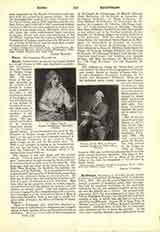

Kauffmann, ANGELICA, b. at Coire, in the canton of Grisons, Switzerland, October 30, 1741; d. at Rome, November 5, 1807. She was the pupil of her father, Johann Joseph, a painter of mediocre talent, who, nevertheless, had an excellent knowledge of the principles underlying his art, and initiated Angelica at an early age into the difficult use of colors. An astonishingly precocious child, she was summoned to Como by the bishop, Monsignor Nevroni, who desired her to make a portrait of him, at which time she had not yet completed her twelfth year. Francis III of Este, Duke of Modena and Governor of Milan, declared himself her protector. Cardinal Roth invited her to Constance and commissioned her to paint his portrait. At the same time Angelica showed a great aptitude for music and singing, and some of her father’s friends strongly urged her to give up painting, but in vain. This episode in her life she has represented in a picture, showing herself, between Painting and Music, bidding farewell to Music. Nevertheless, while cultivating the latter muse less ardently than the other, she was still a clever musician. Italy again attracted her; after visits to Parma and Florence, successively, she arrived, in 1763, at Rome, where she attended Winckelmann’s courses in perspective. On a visit to Venice she made the acquaintance of some English noblemen, and a result of this meeting was her decision to take up residence in London (1766). Reynolds, whose portrait she executed, accorded her a most flattering reception, and conceived for her a passion to which she could never give any encouragement. Among the pictures which she painted in England we may mention “The Mother of the Gracchi”, “The Sacrifice of Messalina”, the “Meeting of Edgar and Elfrida”, and “Cupid and Psyche”. She also engraved many of her works. Her vanity made her the victim of a cruel deception: she allowed herself to be captivated by the engaging manners of a stranger who represented himself to be Count Frederick de Horn, and married him (1767). When the imposture was discovered, a separation followed (1768). The talent of Angelica Kauffmann, suggestive of the Reynolds manner, was highly appreciated in England. The Royal Academy of London elected her as one of its original members. Gessner and Klopstock sang of her, and the latter, in recognition, received a sentimental picture. The pretended Count de Horn having died in 1781, Angelica was free to contract a second marriage; she married the Venetian painter, Antonio Zucchi, and they determined to return to Italy. After a sojourn at Venice, during which Angelica painted “Leonardo da Vinci dying in the arms of Francis I“, they visited Naples and then went to Rome to establish themselves permanently. There she opened a salon, where G. de Rossi and Seroux d’Agincourt, the latter then engaged on his “Histoire de l’art par les monuments”, were frequently to be seen. Goethe, when he visited Rome, was also received in her salon, and speaks of it in the account of his journey. She painted for the Emperor Joseph II, who was then traveling in Italy, the “Return of Arminius victorious over the legions of Varus” and “Aeneas celebrating the Funeral Rites of Pallas”. In the last years of her life she was sorely tried by reverses of fortune and by the death of her husband (1795). “The poverty does not terrify me”, she confided to an intimate friend, “but the loneliness kills me.” She languished for some twelve years. The academicians of St. Luke assisted at her obsequies in the church of S. Andrea delle Frate, where she was buried. It was chiefly as a portrait-painter that Angelica Kauffmann was distinguished; her light touch is not wanting in grace, nor her coloring in brilliancy. In this genre, the portrait of the Duchess of Brunswick, sister of George III, is considered her masterpiece. Her portrait of herself is to be seen in the Berlin Museum. Her historical pictures are altogether inferior; the sentimentalism of the period in which she lived contributed to their vogue, and they have since declined considerably in the general estimation, chiefly because the drawing leaves too much to be desired.
GASTON SORTAIS

